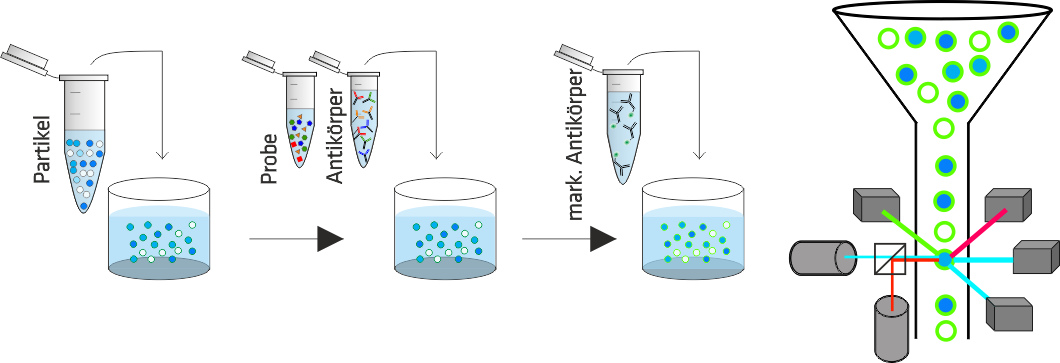
Quadruplex determination of four markers using SAFIA: The sample is mixed with reagents (particles and antibodies) and analyzed using a flow cytometer.
Source: BAM, Environmental Analysis division and Chemical and Optical Sensing division
Monitoring waste water contamination of natural waters can be accomplished by detection of so-called “anthropogenic markers”. These are substances, that do not naturally occur in the aquatic environment. Drug residues, food ingredients and endogenous metabolic products are prominent examples of anthropogenic markers. Their degradation behavior can also be used as indicator for removal efficiencies in waste water treatment plants. In this article, we describe the development of an analytical method for the parallel quantification of four anthropogenic markers (Caffeine, a bile acid and two pharmaceuticals: Carbamazepin and Diclofenac), covering the mentioned classes of markers. The developed method is an antibody based quick test, called SAFIA (for Suspension Array Fluorescence Immunoassay), and consists of two components. First, of highly selective antibodies, that recognize the molecular structure of the markers. Second, of polymer core-silica shell microparticles, which are used as a platform for the binding of the antibodies. The particles are stained with a fluorescent dye in different concentrations, to make them distinguishable (so called “encoding”). The anthropogenic markers are immobilized on the shell of the particles (one marker per code). For analysis, simply the antibodies, particles and the respective water sample must be mixed together. The antibodies will than bind either the dissolved marker or the surface-bound marker on the particles, depending on the marker concertation. Subsequently, bound antibodies are stained with a second fluorescent dye and the read-out takes place in a flow cytometer: Here, the particles become hydrodynamically separated and pass a laser-beam, which excites both fluorescent dyes. The whole assay can be exe-cuted in this mix-and-read manner without any washing steps, which are usual for other immunoassays. After optimization of SAFIA, real waste water samples were analyzed in order to demonstrate the applicability. SAFIA showed excellent accuracy in the analysis of these samples. The results were in good agreement with a chromatographic reference method (LC-MS/MS) and a conventional immunoassay (ELISA). Due to the short time of analysis and high user-friendliness, SAFIA can be used as a process analytical tool, e.g. in waste water treatment plants.
Wash-Free Multiplexed Mix-and-Read Suspension Array Fluorescence Immunoassay for Anthropogenic Markers in Wastewater
Peter Carl, Dominik Sarma, Bruno J. R. Gregório, Kristin Hoffmann, Andreas Lehmann, Knut Rurack, Rudolf J. Schneider, published in Analytical Chemistry Vol. 91, Issue 20, pages 12988-12996, 2019
BAM, Environmental Analysis division and Chemical and Optical Sensing division


